Corgis are a special breed. Their Short stubby legs and round sausage-type bodies combined with unbeatable, playful, and fun-loving personalities. They are delightful pets to have!
Another adorable characteristic of Corgis is their tail….. or perhaps the lack thereof! Whether a little stub tail or a long natural full tail it certainly can tell us a lot about our dogs as well as add a whole other dimension to their personalities!
I live to understand every little detail about our lovable pets and so in the pursuit to know all I can about a Corgis tail I have created this ultimate guide with everything there is to know about your adorable Corgi’s Tail.
What does a Corgi Tail Look Like
The look of a Corgi tail has a wide range. In countries where docking is allowed Pembroke Welsh Corgis will have very short docked tails, or a short natural stub tail. Cardigan Welsh Corgis will have a long natural bottle brush tail that is low set and extends out behind its body.
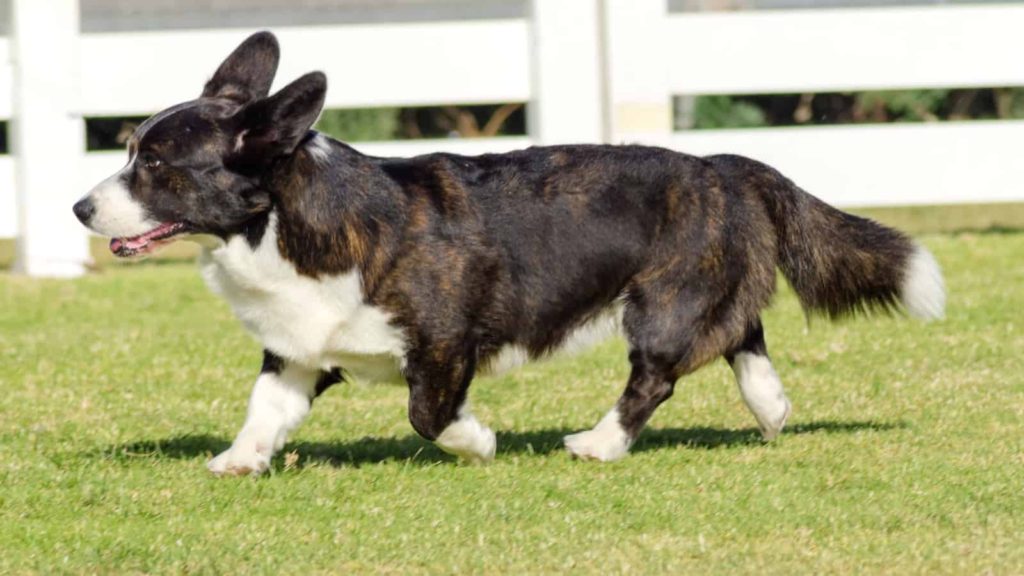
There are 2 different types of Corgis, they each have very uniquely looking tails.
A Pembroke Welsh Corgi will have either a natural stub tail or they will most likely have a docked tail. In rare cases, Pembroke Welsh Corgis may have a full-length bottle brush tail if it is not docked or a genetically stubbed tail.
A Cardigan Welsh Corgi does traditionally have an un-docked tail and will have a long fox-like tail that is fluffy and hangs level with its body.
You may run across an ‘American Corgi‘ which is not a recognized breed but is a mix between the Pembroke and Welsh Corgi. This mixed breed dog will often have an intact long natural tail similar to the Cardigan Welsh Corgi.
If there are twists or kinks in the tail that could indicate a genetic flaw. Twists or kinks could also be from a previous injury of the tail.
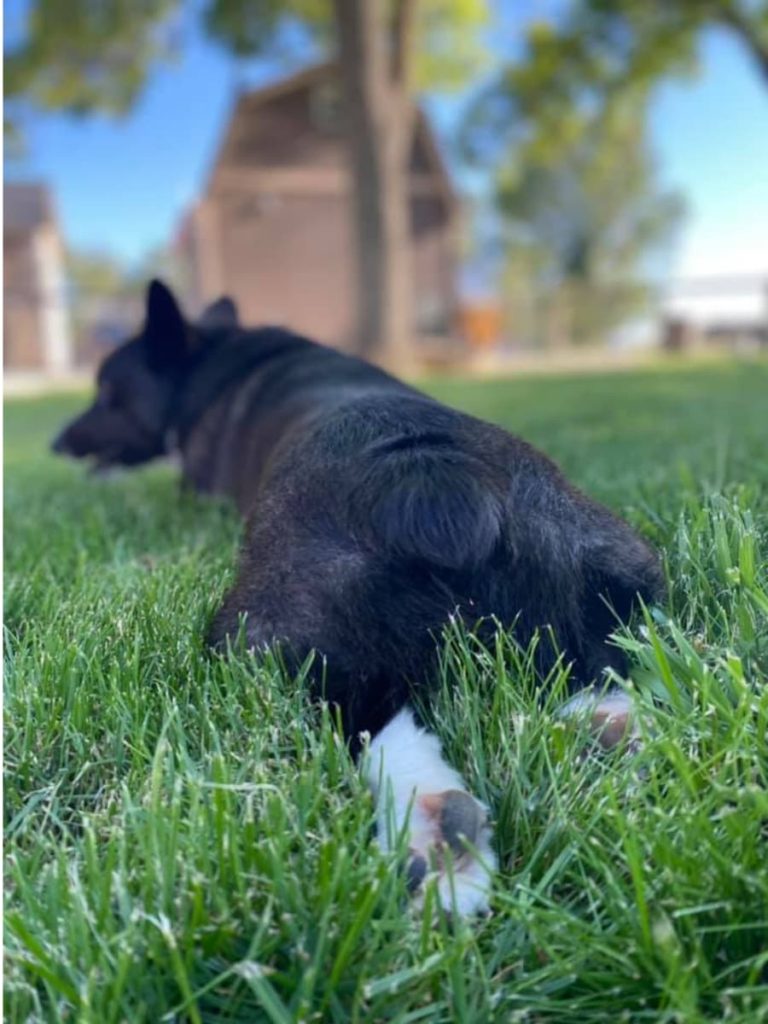
Pictures of A Natural Corgi Tail
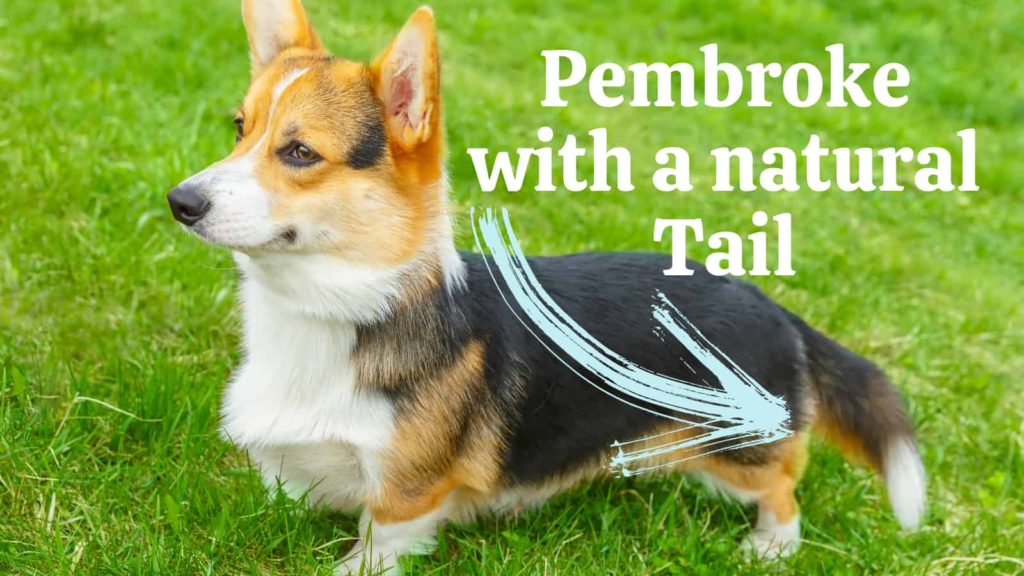
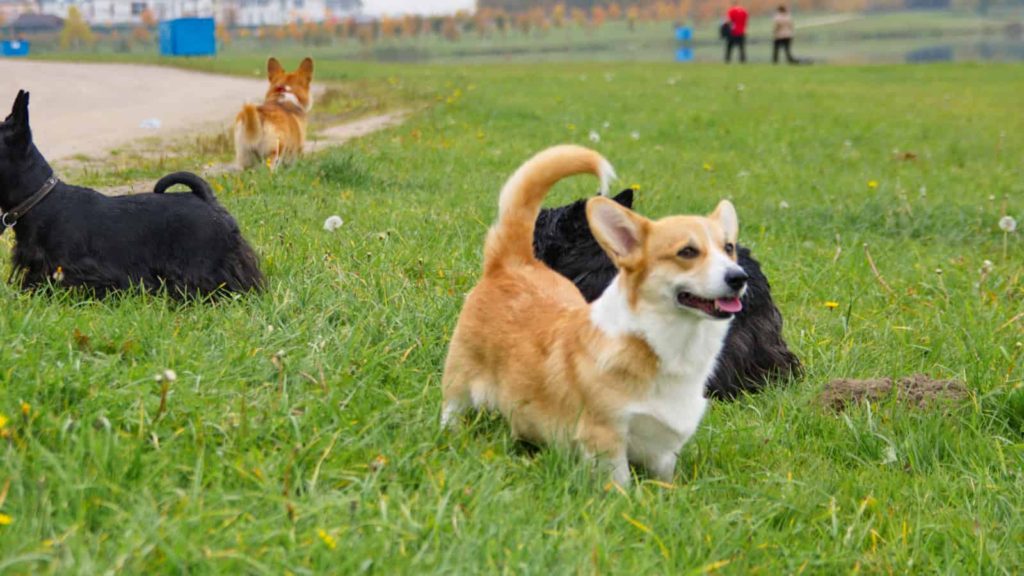
Are Corgis Born With Tails?
Whether Pembroke or Cardigan all Corgis are born with tails, mostly long fox-like tails but some Pembroke Welsh Corgis are naturally born with a stub tail.
As docking continues to become outlawed in many countries (link to Wikipedia article) breeders are doing more to preserve the natural bobtail by selective breeding.
Breeders will choose to breed dogs who have the ancestral T-box gene mutation (C189G) which is responsible for the bobtail. This is a dominant gene meaning that it only takes one of these genes for the trait to manifest.
Disclaimer: This post may contain affiliate links. We only recommend high-quality products that are used and recommended by real owners. If you use these links to buy something we earn a small commission.
How long are Corgi Tails?
Corgi Tails can vary in length Corgis born with a natural stub tail are 1 or 2 inches long. Corgis with docked tails are docked to be as short as possible without an indentation (usually) less than 2 inches long. Cardigan Welsh Corgis’ tails are on average are 8 to 12 inches long with some being as long as 14 inches.
Do Corgis Have Docked Tails?
The Majority of Pembroke Welsh Corgis that are not naturally born with a stub tail and are born in the US or Canada will have their tails docked between 2-5 days old. This is to conform with the breed standards of the AKC and CKC. In countries such as Australia and the UK docking of tails has been banned.
Some breeders who are not registering their puppies with the AKC will choose not to dock their litters’ tails. Corgi owners have told me that it is difficult to find these breeders. Some breeders also will allow you to choose if you want your Corgi puppy to have a docked tail or not if you pay upfront for the puppy before it is born.
Cardigan Welsh Corgis do not have docked tails. It is completely acceptable and very standard for their tails to be left long and full and fluffy.
Why does one kind of Corgi have its tail docked but not the other? I wondered this too.
Cardigan Welsh Corgis historically don’t have docked tails this is because they were bred to herd sheep and having a long bushy tail helped the shepherd see their dog amongst the sheep in the field. There seemed to be little to no danger of them getting their tail stepped on by the sheep.
Pembroke Welsh Corgis on the other hand were bred to herd cattle. Cows are a lot bigger and more dangerous to herd and be around than sheep. This particular type of Corgi’s tails was docked to prevent them from being injured in the field.

Why Do they Cut (Dock) Corgis Tails
Docking is a tradition that dates back to Roman times where they would dock a dog’s tail because they believed it prevented rabies. In the United stated the practice of docking tails for cosmetic reasons began in the 1950s. This was done to conform to the breed standards and be accepted into the AKC.
Pembroke Welsh Corgi tails were traditionally docked to prevent injuries while herding livestock. Now their tails are docked for cosmetic purposes and to conform with the breed standard that the AKC sets. Cardigan Welsh Corgis do not typically have docked tails.
Fun Fact: In the 18th century there was a tax imposed on all dogs unless they were working dogs. So naturally, people decided to cut all ‘Working dogs’ tails off to tell them apart from non-working dogs. And well, that led to owners cutting off their non-working dogs’ tails just to avoid getting taxed.
Because Corgis have such short legs and because their tails hang back and are set low, their tails are fairly close to the ground. It could be very dangerous for a Corgi if a cow were to step on its tail. If this were to happen it could cause a broken tail or spinal injury.
Corgis also naturally have a long fluffy fox-like tail and in the pastures would be exposed to a lot of stickers and burs that could get stuck in their hair and cause pain or infection.
Other herding dogs such as Border Collies have tails that are higher up and so are not in danger of getting stepped on or injured, thus Border Collie tails were never docked.
Why do Breeders Cut (Dock) a Corgis Tail
Breeders will dock Corgis tails if they are following the AKC standard for the Pembroke Welsh Corgi. In order to register their pups with the AKC as well as have them eligible to become show dogs, they have to follow the standard which is a docked tail.
Breeders may have an incentive to have their puppies registered with the AKC as it is a type of a status symbol and there are a number of benefits for the breeder to have their pups registered.
They not only get recognition for conforming to the breed standard they may have an easier time finding a new home for their pups and getting top dollar.
Many buyers prefer to buy a puppy that is registered with the AKC in order to ensure that they are purebred. They also have to go through some rigorous genetic testing and health screenings.
Generally, a breeder that follows the AKC standard has been very careful to breed dogs that are very healthy and free of genetic health problems.
This can ensure someone who is buying an AKC puppy that their dog is healthy and well-bred. It also allows breeders to charge more money for their puppies.
The Process of Docking a Corgis Tail (When and How)
Corgi tails are most often docked between 2-5 days old. There are 2 ways that the docking may be done. One is to make a surgical cut with special shears about 1 in below the base of the tail, the other is to band the tail in the same place and allow the remaining part to either be reabsorbed or to drop off on its own.
Either way, the docking should always be performed by a licensed vet in order to ensure that there are no complications such as infection or nerve damage.
Docking is done on puppies at such a young age because the cartilage is soft and the bones have not yet developed.
Dogs who are older than 8 weeks will have vertebrae in their tails that will need to be carefully cut around. Dogs this age and older will need to have anesthesia in order to avoid the sharp pain of the procedure.
What do Docked Tails Look Like on a Corgi
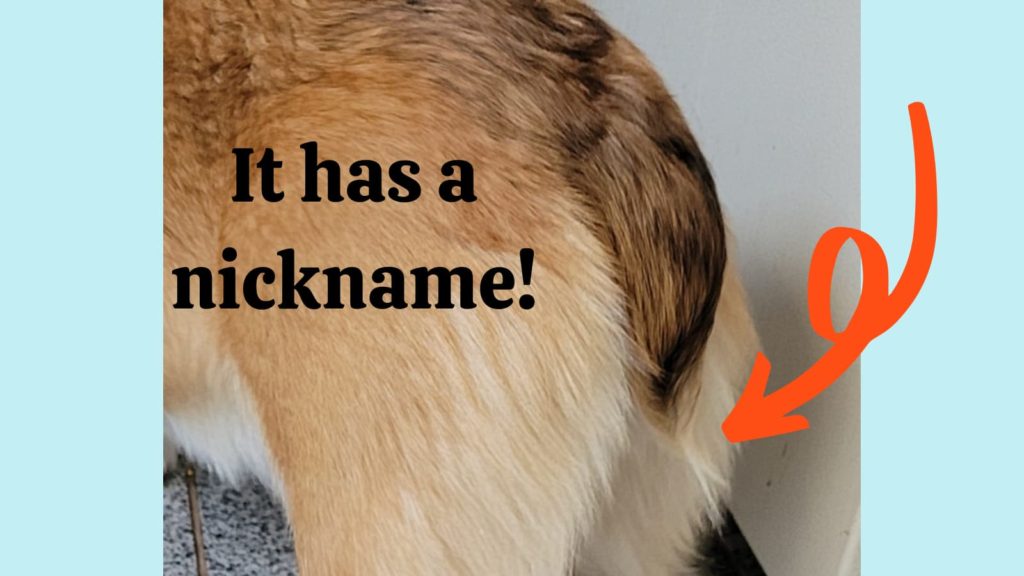
You may notice that your Corgis cute stub tail comes with a bit of extra tail growth on the end. This bit of extra hair is pretty adorable and has been affectionately named many things by corgi owners including:
Duck Tail
Little Radar
Smart Stand
Feather Duster
2nd Tail
Rat Tail
Corgi Tail Docking Ban and Controversy
Tail docking in general has been widely controversial over the last decade or so. There have been many advocates that say it is painful and unnecessary for a Corgi to have its tail docked. Many countries such as Australia and Switzerland have banned the practice making it illegal.
Tail docking is still legal in the United States and doesn’t show any signs of changing.
Some Corgi owners are very disappointed by the bans and restrictions on tail docking. They insist that a Corgi is not a Corgi without a stub tail. They are concerned that with the ban on tail docking that Corgis will become an endangered breed.
Other Corgi lovers are pleased with keeping a long tail on a Pembroke Welsh Corgi and may even seek out a breeder that is planning to keep the tail on their puppies.
How to Get a Corgi Puppy With a Tail
There are many people who love Corgi tails just as much as Corgis themselves. There have been many dog owners I’ve talked to that have a Corgi or want to get a Corgi and express interest in finding a Corgi with an undocked tail. They love the long and natural tail of a Corgi whether it is a Pembroke Welsh Corgi or a Cardigan Welsh Corgi.
So can you find a corgi with a tail, and if so how do you find a Corgi with a natural tail?
Yes, you can find a Corgi with a tail, Cardigan Welsh Corgis will almost always have a tail but it will take added effort, research, and cost on your part to find a Pembroke Welsh Corgi puppy with an undocked tail.
Here are some things you can try.
- Ask a breeder before the litter is born to leave the tail intact. A lot of breeders will be happy to accommodate if you pay for your puppy upfront.
- Get a Cardigan Welsh Corgi. These types of Corgis are almost always going to have a long fluffy tail.
- Travel to a different country to find your Corgi. Many countries in Europe, parts of Canada, and Australia are all examples of countries that have made it against the law to dock Corgis tails.
You will want to be sure however that neither parent of your new pup has the gene for a bobtail. Or you might end up with a short-tailed Corgi anyway. - Keep an eye out in your local rescue for a Corgi.
- Love the Corgi with or without the tail! It’s a special breed and even without a tail they are so expressive and cute we can overlook the lack of that fluffy bottle brush on their bums.
- Check this list of breeders in the US that have said they can leave the tails intact.
(2) Blacktail Mountain Corgis | Facebook (Salt Lake City, UT)
Quirky Corgis (Oklahoma)
Chloe’s Colorful Corgis | Facebook (Indiana)
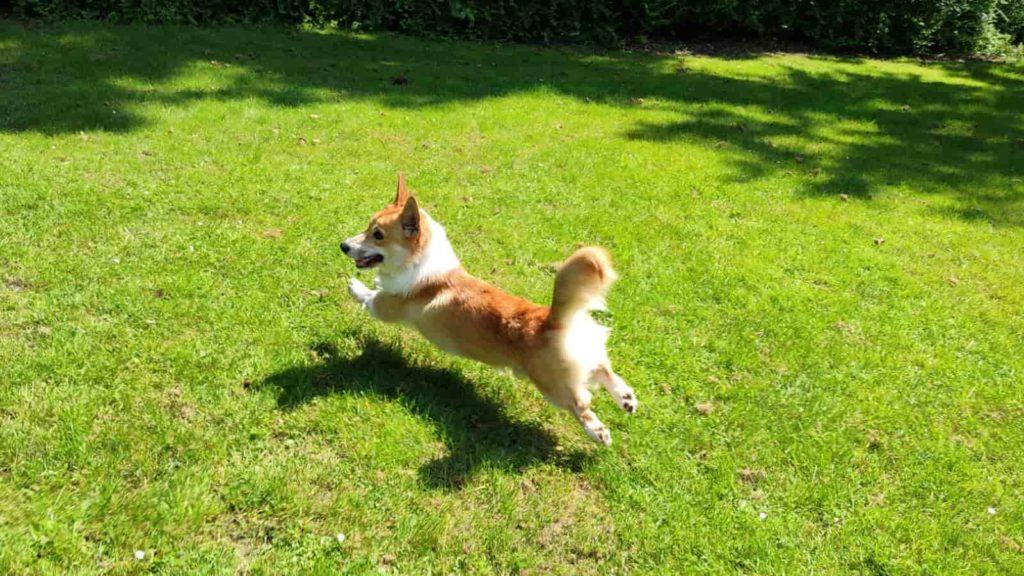
Are Corgi Tails Curly?
Corgis do not have curly or curled tails. Their tails are long and straight and should arc up slightly. If your Corgi has a kink or curl in their tail it could be a sign of a genetic flaw or an injury.
If your Corgi tail curls up and over its body or it has a curly tail this could be a sign that your Corgi might not be purebred. A purebred Cardigan Welsh Corgi will have a long straight tail that extends out from its body and slightly curves upwards.
A purebred Pembroke Welsh Corgi will have the same long tail if it has not been docked. Or a very short docked tail or a stub tail.
The Heart Shape Corgi Tail
Corgi Tails Problems and Solutions
If you have noticed that your Corgi is acting abnormally by not wagging its tail as enthusiastically as it used to, or its tail is hanging down between its legs it could be quite alarming. Seeing our loving pets in pain or noticing something might be wrong can be scary.
Consulting with your vet should always be your first step, but if you are left waiting for a day or two before your furry friend can be seen then you may want some additional information to ease your mind.
Corgi Tail Hanging Down
If your dog is temporarily holding its tail in the down position it’s most likely an indication of submission or guilt, but if your Corgi is unable to hold its tail upright as it has in the past and it seems as if it’s in pain it could indicate a condition called limber tail or possible IVDD (Intervertebral disk disease).
Here is a list of other things that Corgi owners have said cause tail issues in their dogs. We will go into more detail below.
- Anal Glands
- IVDD
- Constipated
- Injury or Broken Tail
- Limber Tail (Swimmers Tail)
Anal Glands
If you notice your Corgi chasing its tail a lot more than usual or scooting its bum across the carpet it could be that its anal glands are blocked and swollen.
Sometimes it’s as simple as our Corgis anal glands needing to be expressed. You can have your vet do it, or learn to do it yourself.
For more information on this you can read this article on Wag Walking.
Does your Corgi eat weird things?
Why Does My Corgi Eat Everything? (Grass, Poop, Sticks, Dirt)
IVDD in Corgi
Another somewhat serious problem that can cause tail discomfort in Corgi is a back issue known as IVDD. The technical term for this is Intervertebral disk disease (IVDD) it can also be described as a ruptured, slipped, bulging or herniated disk in your dog’s neck or back.
This type of back issue is fairly common in Corgis. Quite a few owners that I talked with have had this issue with their dogs. Some have been able to help their dog feel better with resting and medication, some have had to get their pups operated on.
Here is a good resource to look at if you feel like this might be your Corgis problem.
Corgi Broken Tail
Dogs do have bones in their tails and they can, if injured badly enough, break. Since Corgi’s tails are long and thick you will need to be careful with your dog’s tail not to injure it or get it caught in something like a door or a sharp object.
If you think your dog has a broken tail it is important that you take them to your vet.
Signs of a broken tail include swelling, bending, and a kink in the tail. Your dog might have difficulty moving or wagging its tail or is holding it in an unusual position.
Corgi Chasing its Tail or Biting its Tail
For the most part, if your Corgi is chasing its tail it’s most likely just a harmless and adorable game. Puppies tend to do this a lot because they are so playful and explore more about their world and discover their fun long tails. If your dog is chasing his tail it might be because he’s bored or it’s just a fun game for him.
The problem comes when your dog is obsessively chasing its tail and it seems like they are in pain stressed or biting its tail and causing things like bleeding, or hair loss.
If this is the case then rightfully you are probably concerned.
The cause for this could be one of several things. Here are the things that you can look for.
- Impacted anal glands
- Parasites like fleas or ticks in the tail
- Injury or sharp pain somewhere on the tail
- Allergies or itchy skin
- Hotspots
Hot Spots on Corgis Tail
Sometimes Corgis will develop hot spots on their tails or other parts of their bodies. A hot spot is a moist irritation that can be red, inflamed, and moist. They usually start out as allergies or slight skin irritation and if your dog chews or bites at it can become worse.
The best treatment is to keep the spot cool, and dry and keep your dog from licking or itching it. Your dog should wear a cone or a donut to prevent licking.
Keep the spot dry and shaved. You can use corn starch to help dry it out. Your vet may give your dog antibiotics either internally or a cream.
Having your dog take fish oil or krill oil can help to battle hot spots as well.
What is Limber (Swimmers) Tail In Corgis and What to Do
If you notice your Corgi’s tail hanging down and it looks limp and unnatural then he may have a condition known as Limber Tail.
Limber tail Also known as swimmers tail, frozen tail, dead tail, broken wag, or cold tail is a condition that causes your dog to hold his tail limp and down instead of the usual upright position. Its official name is Acute Caudal Myopathy.
It is most likely to happen after your dog has had a very active or strenuous play, exercise, or excessive tail wagging. Sometimes a lot of swimming can cause it, being in cold wet weather, if they are confined to their crate too long, or if your dog’s tail is wagging and getting whacked on various surfaces.
This could cause your dog pain and swelling in their tail, making it difficult to sit. Usually, this condition will go away on its own after a few days of rest. It’s important to try and limit exercise and movement if you notice that your dog is experiencing this problem. If it is causing your dog a lot of pain then consulting your vet is a good idea.
Usually, this isn’t a chronic problem, but it is a good idea to figure out what may have triggered it in the first place and try to avoid that activity if possible. Coldwater play, or being confined in a crate too long are often things that could trigger this condition.
Pro Tip: If your Corgi is limping in combination with a tail problem it’s best to seek help from a vet this article can also be helpful Why Is My Corgi Limping?
Corgi Tail Infection (Tail Tip Necrosis)
This is a very serious problem, but thankfully very rare in Corgi. It can be important though that you learn to identify it right away so the issue can be dealt with before it causes permanent damage.
This can be caused by the constant beating of the tail against objects that may harbor bacteria. If the tail gets an open wound and the bacteria gets in it can lead to an infection that will spread and cause the tissue to become damaged or start dying.
Watch for hair loss at the end of the tail. Excessive itching, bloody or brittle skin, foul-smelling, excessive biting or the tail.
Take your dog to the vet right away if you notice any of these things in your dog. The vet will assess and most likely have to amputate the infected part of the tail. This may be a very sad thing to have to deal with, but if the infection spreads it could endanger your dog’s life.
Keep your Corgi healthy and living longer with these tips.
Corgi and Corgi Mix Lifespan (Insider Info From Owners) – Paws and Learn
How The Corgi Lost Its Tail
Welsh Corgi News – How the Corgi lost its tail
Check out the link above to read this adorable children’s book in blog form talking all about the story of a Corgis and its tail!
Do Corgis Wag Their Tails?
Even though most Corgis only have a little nub of a tail they still do wag their tails, or what little tails they have in order to express how they feel and communicate with their owners. Some Corgis with very short stub tails also wag their entire rear end when they are trying to wag their tail. It’s quite endearing!
Corgi Tail Wagging and Communication
Corgi’s wag their tails (or in the case of a stub tail their butts) for many different reasons. It’s a big part of how they communicate with you.
Wagging their tail doesn’t always mean they are happy. They could be conveying other emotions like nervousness or fear as well. The key to understanding their tail wags is to put it together with all the other contextual clues they are giving you. What are their ears doing, their eyes, how is their posture? Noticing these things as well will help you know why your Corgi is wagging their tail.
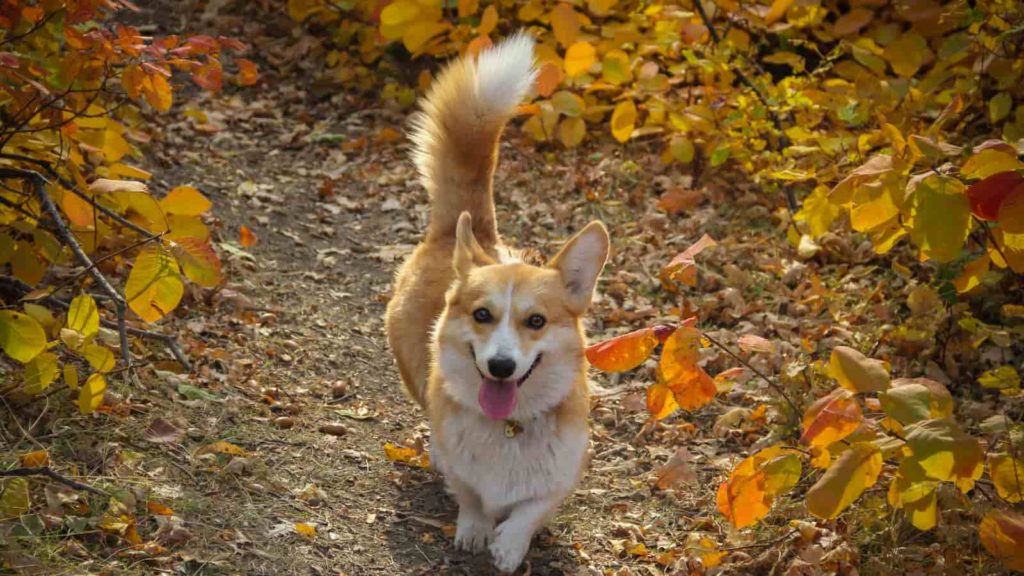
Here are some things your Corgi could be communicating to you with its tail.
- Calm and chill – Tail in the natural resting position. Sleeping or resting or casually walking around.
- Greeting or I love you – Usually, a big carefree wag, accompanied by eye contact, coming to you and jumping on you or trying to get your attention.
- Curious or unsure – Backwards and gentle wagging. Maybe sniffing around a little, intense and curious staring. Looking to you for reassurance.
- I’m nervous or scared – The tail between their legs and possibly slightly moving. Body tense, eyes down, ears laid back. Could also be trying to communicate a submissive position.
- Aggression – Tail high in the air and rigid. Poised, rigid, and making eye contact. Could be barking or growling as well.
- Happy and Excited – Fast care-free wagging. Wiggling body, happy facial expressions. Body not tense, possibly going in circles around the object causing excitement such as a treat or toy.
There’s also been a study done that shows the direction that your dog wags its tail can show positive or negative emotion.
Fun Fact: Wagging their tail towards the right side of their body can indicate more positive emotions such as relaxed, and happiness. Wagging their tails on the left side of their body is a sign of more negative emotions such as nervousness or fear.
Some dogs are bigger tail-waggers than others. If your dog doesn’t wag its tail a lot it’s most likely nothing to be worried about. You will just need to work on identifying other body language cues to help you understand what they are trying to tell you.
If your Corgi has recently stopped wagging their tail then that could mean that there is something else going on. If you have just moved, or they are new to your home this could just mean they are nervous and need some time to get acclimated to their new environment.
How to Groom a Corgi Tail
Corgis with long tails need a little more grooming and care than their short-tailed counterparts.
Generational genetics play a large part in the development of the size, color, and coat texture, of your Corgis fur. That is why established breeders who have show quality Corgis do a lot of research and are very particular in pairing males and females which can be the reason their puppies may be so expensive.
Never Shave your Corgis coat!!
Read This Article to Find out Why:
Shaving Your Corgi (Is it Ever Ok?)
Keeping your Corgis tail well-groomed is mostly going to be regular brushing as well as using a de-shedding tool. It’s important that you keep it well brushed so that it stays free from dirt, burs, or other debris that tends to collect in a Corgi that likes to play outside.
Pro Tip: Having a grooming kit at home can help you maintain your dog’s beautiful coat and keep their tail looking nice and tangle-free!
Other Articles All About Your Corgi:
7 Signs Your Corgi is Jealous? (What to Do) – Paws and Learn
Are Corgis Picky Eaters? (Tips and Tricks From Owners) – Paws and Learn
7 Reasons Why Your Corgi Whines (What to Do) – Paws and Learn
While we strive to give the most accurate and helpful information about your pet’s health that we can, this article is meant to be informational only and not medical advice. Never disregard, avoid or delay in obtaining medical advice from your veterinarian or other qualified veterinary health care provider regardless of what you have read on this site or elsewhere.





